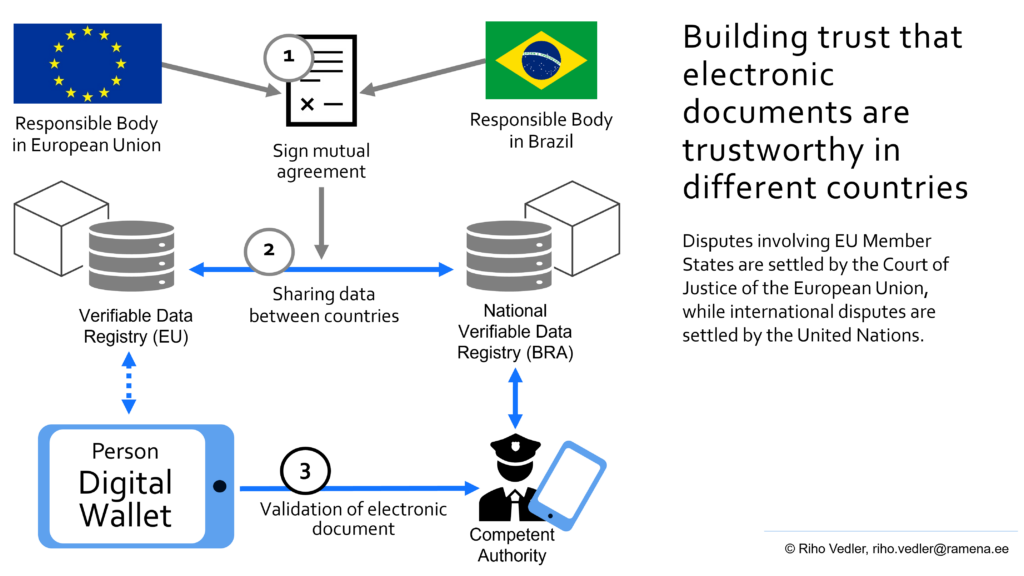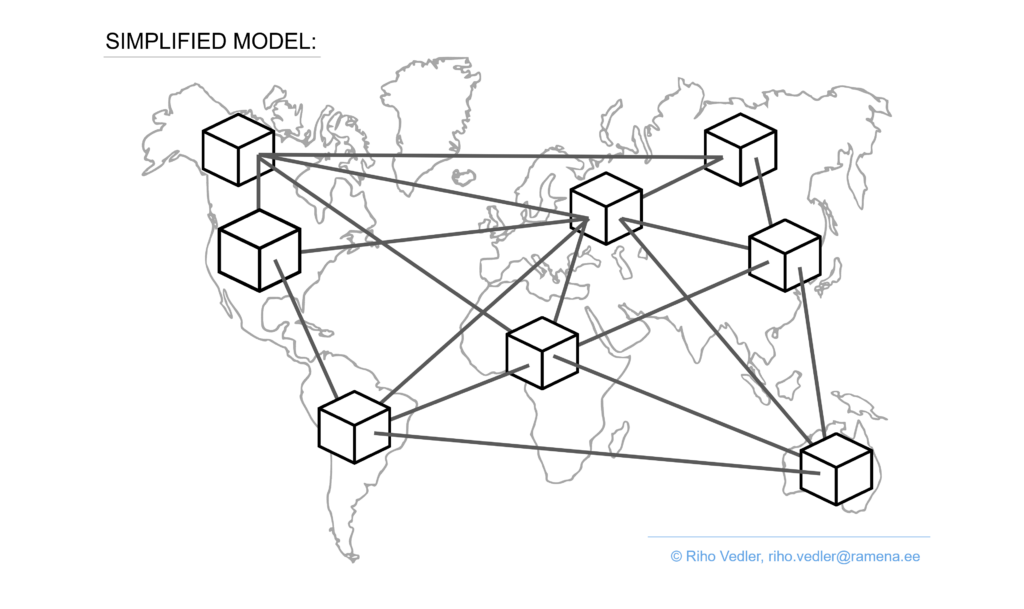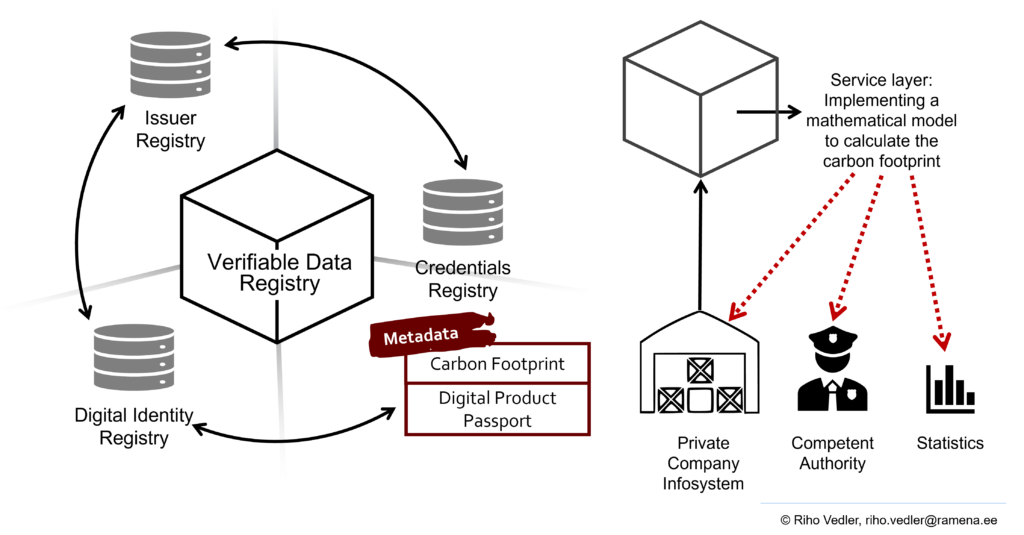Riho Vedler
Digitalization of trade and logistics can contribute to sustainability efforts by optimizing transportation routes, reducing fuel consumption, minimizing emissions, and improving overall resource efficiency. The adoption of digital technologies enables better visibility and control over logistics operations, allowing for proactive monitoring and optimization of energy usage, waste management, and carbon footprint reduction. The environmental impact of logistics operations is a growing concern.
Key factors we need to consider:
• DIGITAL IDENTITY AS PART OF DIGITAL WALLET. Digital identity in the context of electronic signatures involves the use of digital certificates, cryptographic keys, and other secure mechanisms to establish the identity of the signer and ensure the integrity of the signed document. These mechanisms link the signer’s digital identity to their electronic signature, providing trust and legal validity to digitally signed documents.

Important laws and legislation governing the subject:
o EU | eIDAS2.0. Proposal for a Regulation of the European Parliament and of the Council amending Regulation (EU) No 910/2014 as regards establishing a framework for a European Digital Identity https://eur-lex.europa.eu/legal-content/EN/TXT/?uri=CELEX%3A52021PC0281
o UN | UNCITRAL. Model Law on the Use and Cross border Recognition of Identity Management and Trust Services https://uncitral.un.org/en/mlit
• STANDARDIZATION AND CROSS-BORDER DATA EXCHANGE. Standardization promotes interoperability, enabling different systems, platforms, and technologies to work together effectively. When supply chain participants adhere to common standards, it becomes easier to integrate diverse systems and exchange data seamlessly. This interoperability enhances collaboration and enables real-time visibility into the movement of goods, inventory levels, and other vital information across the supply chain.
Important laws and legislation governing the subject:
o EU | eFTI. Regulation (EU) 2020/1056 of the European Parliament and of the Council of 15 July 2020 on electronic freight transport information (eFTI) https://eur-lex.europa.eu/legal-content/EN/TXT/?uri=CELEX%3A32020R1056
o UN | MLETR. UNCITRAL Model Law on Electronic Transferable Records https://uncitral.un.org/en/texts/ecommerce/modellaw/electronic_transferable_records
• MACHINE LEARNING (AI) AND ARTIFICIAL INTELLIGENT (AI). AI and ML plays a significant role in optimizing supply chain operations by analyzing large volumes of data, detecting patterns, and generating actionable insights. This allows supply chain professionals to make informed decisions regarding demand forecasting, inventory management, logistics planning, and risk mitigation. Increasing volumes of goods on an international scale have led to a situation where the involvement of machine learning and artificial intelligence in process management is essential.
• DIGITAL PRODUCT PASSPORT (DPP). A DPP refers to a digital document or record that provides comprehensive information about a specific product throughout its lifecycle. It serves as a digital representation of the product’s identity, characteristics, attributes, and history. The purpose of a DPP is to enable transparency, traceability, and access to relevant information about the product, promoting sustainability, accountability, and consumer trust.
Interesting links concerning this topic:
o The EU Digital Product Passport https://www.wbcsd.org/Pathways/Products-and-Materials/Resources/The-EU-Digital-Product-Passport
o Energy and Mines Digital Trust pilot
o Implementing Digital Product Passports using decentralized identity standards https://medium.com/spherity/implementing-digital-product-passports-using-decentralized-identity-standards-f1102c452020
• CARBON FOOTPRINT. Measuring and monitoring the carbon footprint is essential for understanding the environmental impact of human activities and identifying areas for emissions reduction and mitigation strategies. It allows individuals, organizations, and governments to make informed decisions, implement sustainable practices, and take actions to reduce their contributions to climate change. The concept of carbon footprint is closely tied to efforts to combat global warming and transition to a low-carbon and sustainable future.
Interesting links concerning this topic (use chrome translator):
o Carbon footprint will go down in history, now we’re counting environmental damage https://www.hs.fi/talous/art-2000009569153.html
If we combine the previously defined needs, we can define the following model:

Now we need a good data exchange model what we can use in national and cross-border level. For this purpose, the Verifiable Credential (VC) exchange model is suitable in data exchange between business to business and business to government (or to competent authority). This model can be used both nationally and internationally, and for the verification of various electronic documents (driver licenses, insurances, special permits, etc.).
The VC concept is based on the approach that data belongs to the owner and the owner can decide who has access to the data and for how long.
Data exchange between different countries on base VC data exchange model:

In building a global ecosystem of ‘Verifiable Data Registries’, we can use Blockchain, DLT or any technology that can exchange data between registries in different countries. This whole ecosystem is based on an architecture of zero trust (we keep in ‘Verifiable Data Registry’ only minimum data fields to validate any electronic document or data set). It is worth pointing out that the ‘Verifiable Data Registry’ does not share personal information.
View of ‘Verifiable Data Registries’ global ecosystem:

As part of the shared ‘verifiable credentials’ there is also metadata, this data can be presented together with various documents and used for analysis (such as carbon footprint below, digital product passport, etc.) as reader can see in figure below.

Key messages
As we can see, advances in technology have given us the opportunity to design the entire supply chain data exchange by involving different layers in the process. All of this makes it possible to create tools that can be used to link carbon footprints, for example, to the decision-making level in the company.
Especially highlight benefits of using the digital identity, digital wallet and verifiable data registry for supply chain digitization process:
- Digital (Identity) Wallet – a handy tool for managing logistical processes
- People learn how to use their ‘Digital Identity’ and ‘Digital Wallet’ in the workplace to perform their job tasks (warehouse workers; drivers; Competent Authorities, etc.)
- This, in turn, will accelerate the use of the same technology in other areas at leisure
- The rest of the world also needs to catch up quickly with the technology being selected and deployed, as logistics is first and foremost a global industry.
Of course, this approach raises several additional questions, but we can divide the question into one or another group:
- Technical Questions and Challenge.
We must build such a technical ecosystem that supports different mathematical models related to ‘Carbon Footprint’, ‘Digital Product Passport’, etc. - Politics and Opportunities.
- Choice A. We archive on a political level agreement what mathematical model we use in the process
Choice B. We use the same basic data fields but define results by different mathematical models as a technical system supports such an approach.
Example: Europe uses the results of Model A, China uses the results of Model B … with taxes.
- Choice A. We archive on a political level agreement what mathematical model we use in the process
Also, a shared approach does not provide today answers to all technical questions. Many things need to be solved step by step.
If we choose any technology, then it is important to give preference to solutions that are simple, secure, and as decentralized as possible, don’t destroy existing technical ecosystems (company or organization level, certification processes) and of course with the least political influence. It is good to see that many national experts support shared technical approach to the digitization of logistics and supply chains.
Now it is time for governments to give their approval to this approach!
Riho Vedler is the international supply chain digitization expert at Ramena.ee and independent digitalization expert at European Commission Digital Transport and Logistics Forum (DTLF)



















